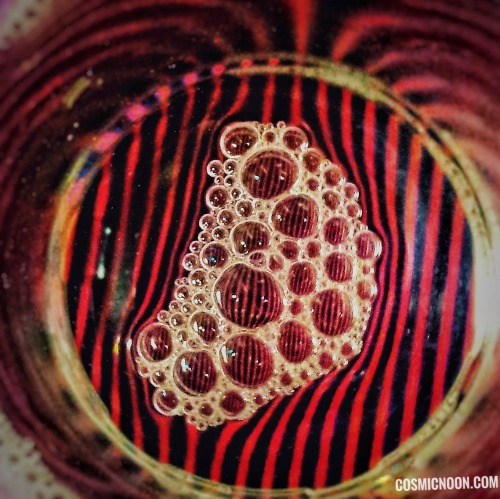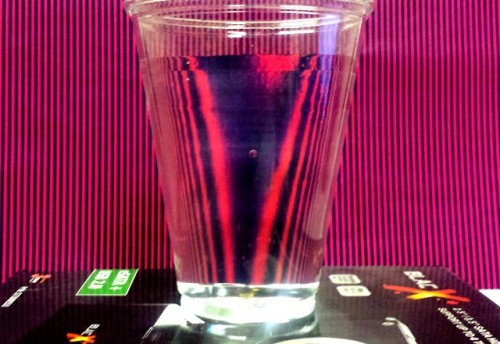#flow series
Flow galleria (#1) : Oil film viewed using Polarizing Filters
In this image a film of oil placed in between plastic sheets is captured by passing the background light through two polarizing filters.
** This post is part of the ‘Flow series’ by FYPhysics and EcstasyShots!. Check out the previous posts here.
Post link

When you wake up in the morning and open/close your faucet when you brush your teeth, you might have noticed that it undergoes a transition between a smooth jet to a dripping flow like so :
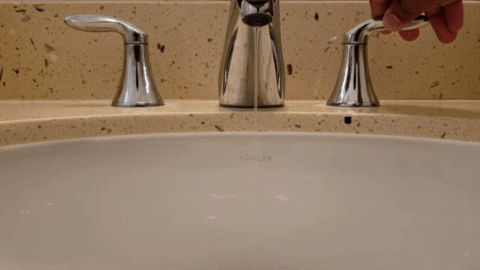
When the velocity of the fluid exiting the faucet is high, it appears smooth for a longer time before it breaks into droplets:

But when you make the velocity of the fluid exiting the faucet low, it seems to form droplets much earlier than before.
Here’s the water breaking into smaller droplets shot in slow motion:

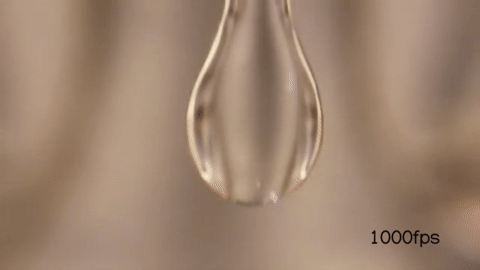
Notice that just by changing the exit velocity of the water you can control when the droplets form.
You can also control the nature of the droplets that form by changing fluids. Here’s how it looks like if you use water as the fluid (left), pure glycerol(center) and a polymeric fluid(right).

What is causing a jet of fluid to form droplets?
A simple answer to this is perturbations on the surface of the fluid. What does that mean?
Initially the fluid is just falling under the influence of gravity. And velocity of any freely falling object increases as it falls:

But the surface tension of the fluid holds the molecules of the fluid together as they fall down.
Therefore depending on the initial velocity of fluid, the surface tension of the fluid and the acceleration you get a characteristic shape of the jet as it falls down:

This is what you observe as the fluid exits the faucet.
Perturbations
Just after exiting the faucet, there are tiny perturbations on the surface of this fluid as it falls down. This is apparent when you record the flow at 3000fps:
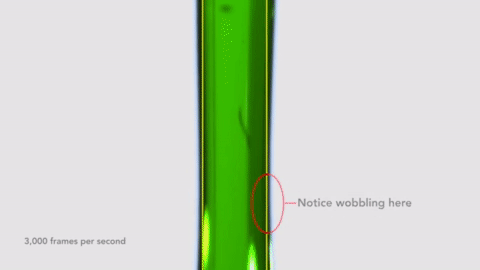
Source: engineerguy
Those tiny perturbations on the surface of the fluid grow as the fluid falls down i.e the jet becomes unstable.
And as a result the fluid jet breaks down to smaller droplets to reach a more thermodynamically favorable state. This is known as the Plateau-Rayleigh instability.

It takes different fluids different time scales to reach this instability. This depends on the velocity of the fluid, the surface tension and the acceleration it experiences.

And some viscous fluids like honey are also able to dampen out these perturbations that occur on their surface enabling them to remain as fluid thread for an extended time.
A note on inkjet printers
By externally perturbing the fluid instead of making the fluid do its own thing, you can make droplets of specific sizes and shapes.
This engineerguy video explains how this is used in inkjet printers in grand detail. Do check it out.
We started today by trying to understand why water exiting a faucet behaves the way it does. Hopefully this blog post has gotten you a step closer to realizing that. Have a great day!
Sources and more:
* This is a topic that is home to a lot of research work and interesting fluid dynamics. If you like to explore more take a look into the mathematical treatment of this instability here.
** This post is part of the ‘Flow series’ by FYPhysics and EcstasyShots!. Check out the previous posts here.

Let’s ask a very generic question:
I hand you an object and ask you to predict whether the object would float or sink. How would you go about doing that ?
Well, you can measure the mass of the object and the volume of the object and can derive this quantity called Average Density

It is the average density of the entire object as a whole. If this object is submerged in a fluid of density , then we can draw the following force diagram:


Fun Experiment:
If you drop some raisins in soda, you will notice that they raise up and fall down like so (Try it out!):
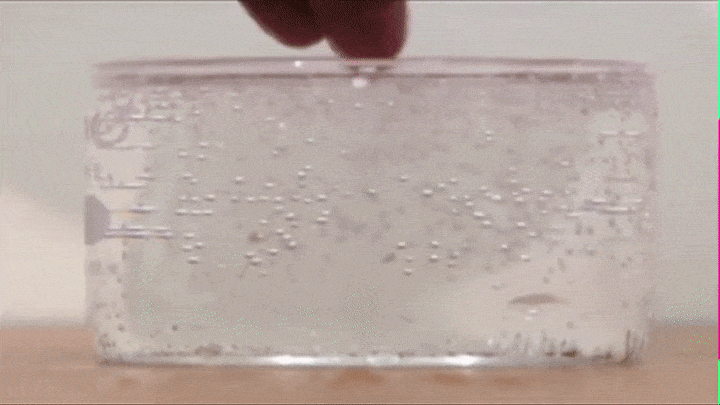
This is because air bubbles that form on the top of the raisin decrease its average density to the point that its able to make the raisin raise all the way from the bottom to the top.
BUT once it reaches the top all the air bubbles escape into the atmosphere (its average density increases) and the raisin now falls down.
Questions to ponder:
- Why do people not sink in the dead sea ?
- How are submarines/divers able to move up and down the ocean ? How would you extend the average density argument in this case.
- Why do air bubbles in soda always want to raise up ?
- If the total load that needs to on a ship is 25 tons. What should be the total volume of the ship in order to remain afloat if the density of sea water is 1029 kg/m3,
** This post is part of the ‘Flow series’ by FYPhysics and EcstasyShots!. Check out the previous posts here.
Buoyancy
In the first post of our fluid mechanics series : ‘Flow’ we explore the concept of Buoyancy. Click here to check out the post exploring the physics of Buoyancy.
Have a great day!
* Check out the video description on YouTube on the details of how buoyancy is related to each clip in the video
Flow Galleria (#6) : Magic of a bright striped background
One of the easiest way to visualize fluid phenomenon is by placing your fluid on top of a bright striped background. And by measuring the deviations of this striped pattern, it is possible to infer a lot of sensible data such as the changes in density of the fluid and so on. In this post, this technique is demonstrated in water using an alternating red-black striped pattern as the background.
If the region of interest is only the surface on the other hand, the bright striped pattern can be made to reflect off the top of the fluid surface. We demonstrated this technique in our ‘Water is diamagnetic: A simple experiment’ post which you can check out here.
Cheers!
Post link
Flow Gallleria(#3): Cup of water against a striped background
One interesting variation on the cup of water against an arrow in the background (top gif) is if you replace the arrows with a striped background. This opens the door for some interesting visualizations on refraction as well. Try it out!
** This post is part of the ‘Flow series’ by FYPhysics and EcstasyShots!. Check out the previous posts here.
Post link




